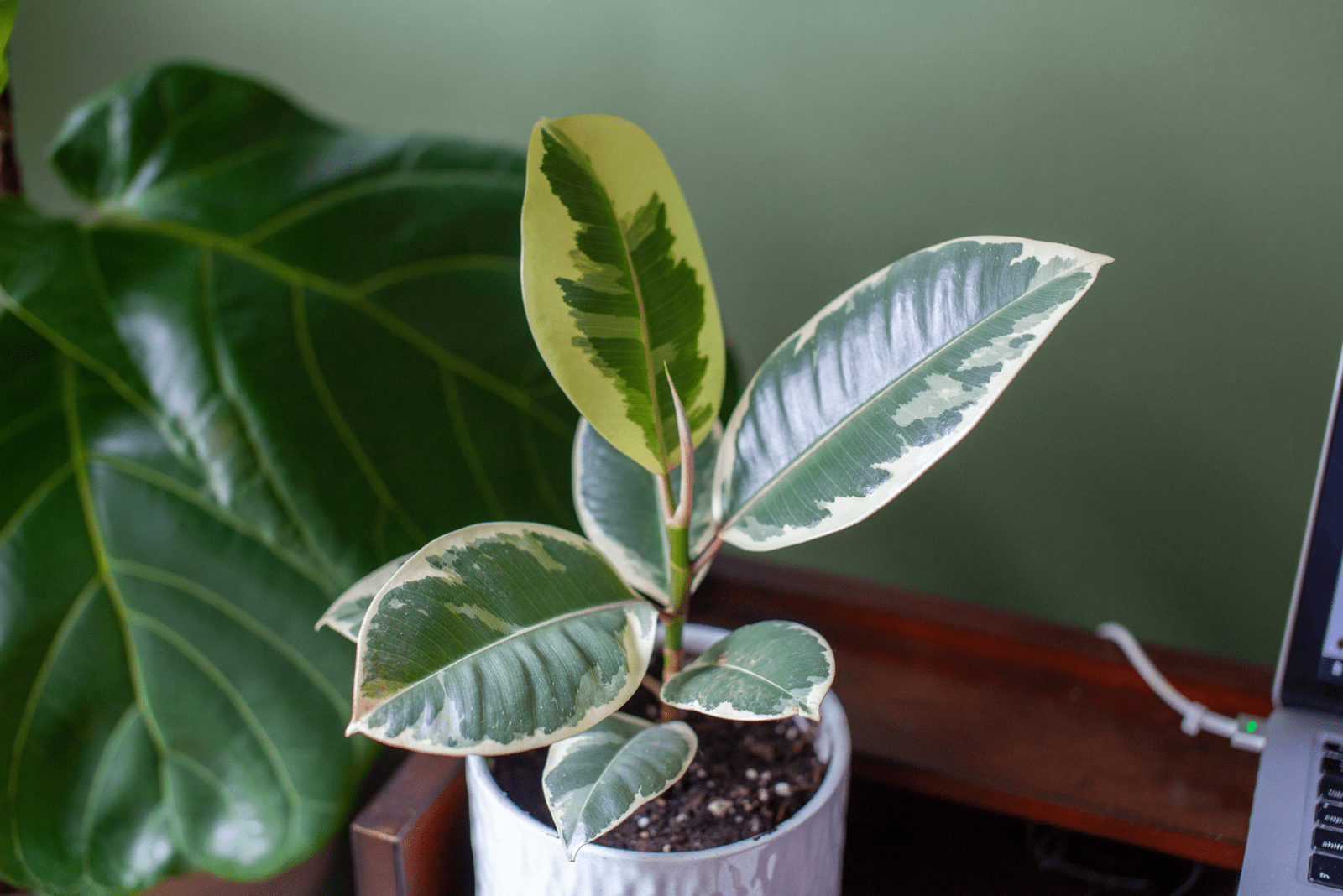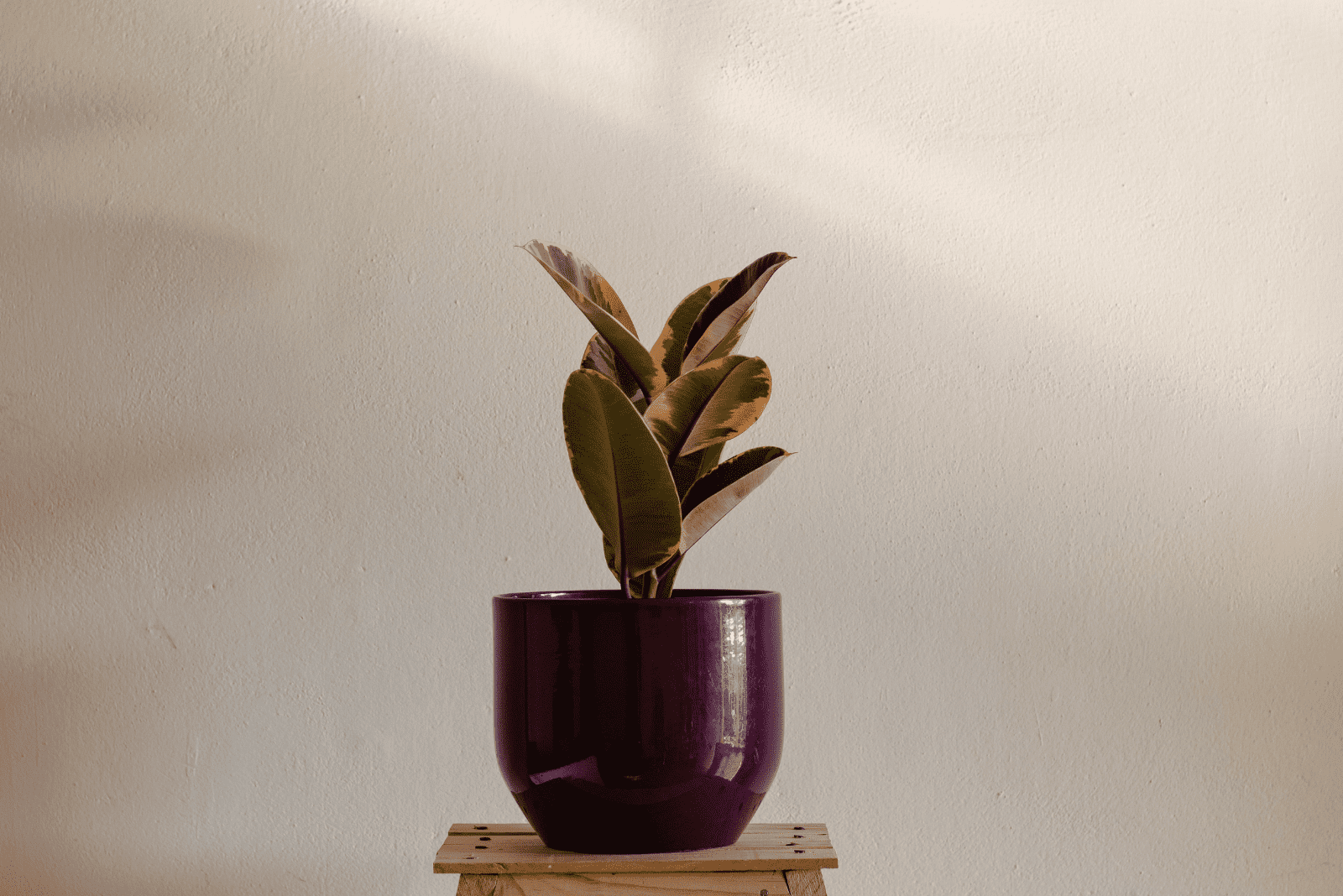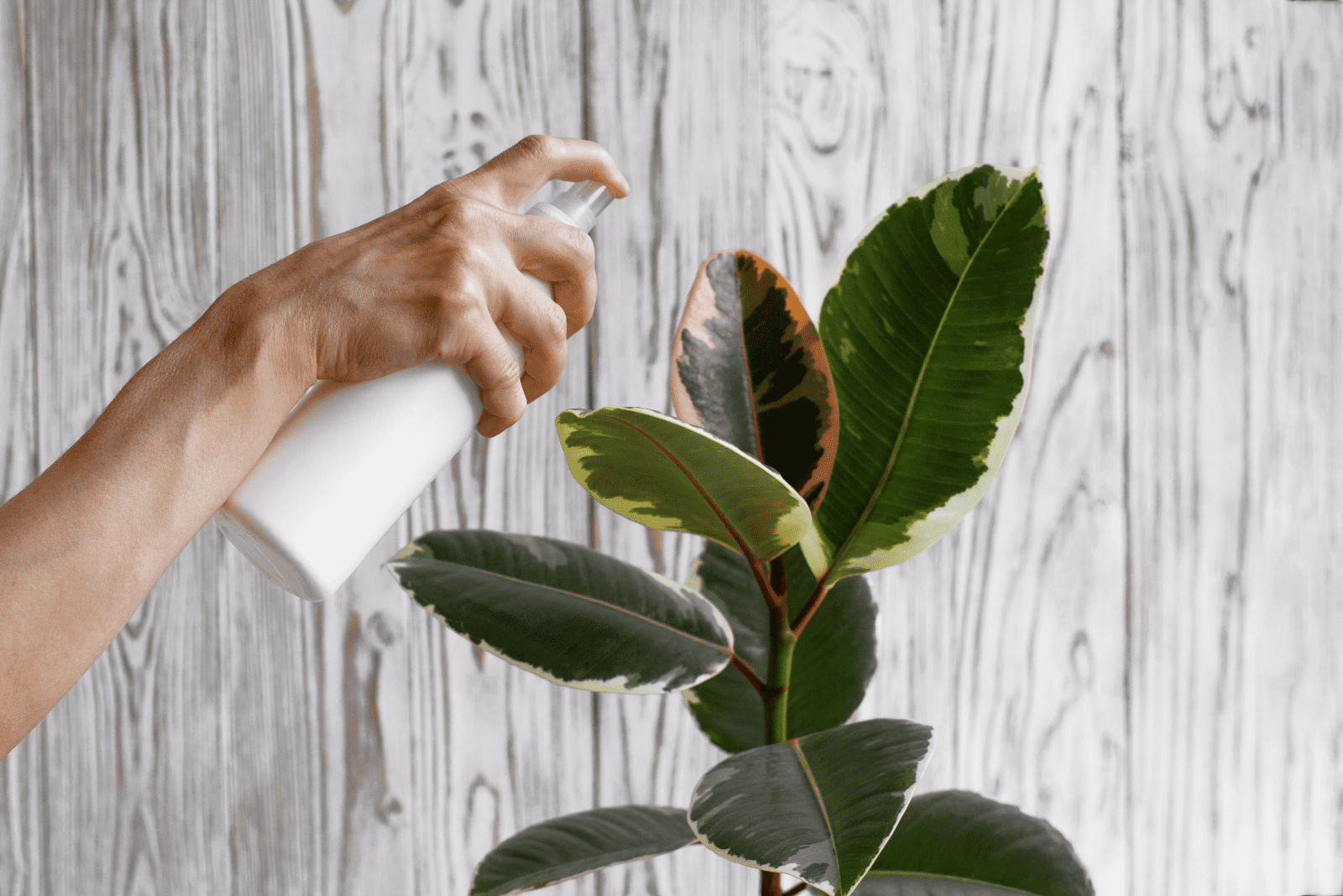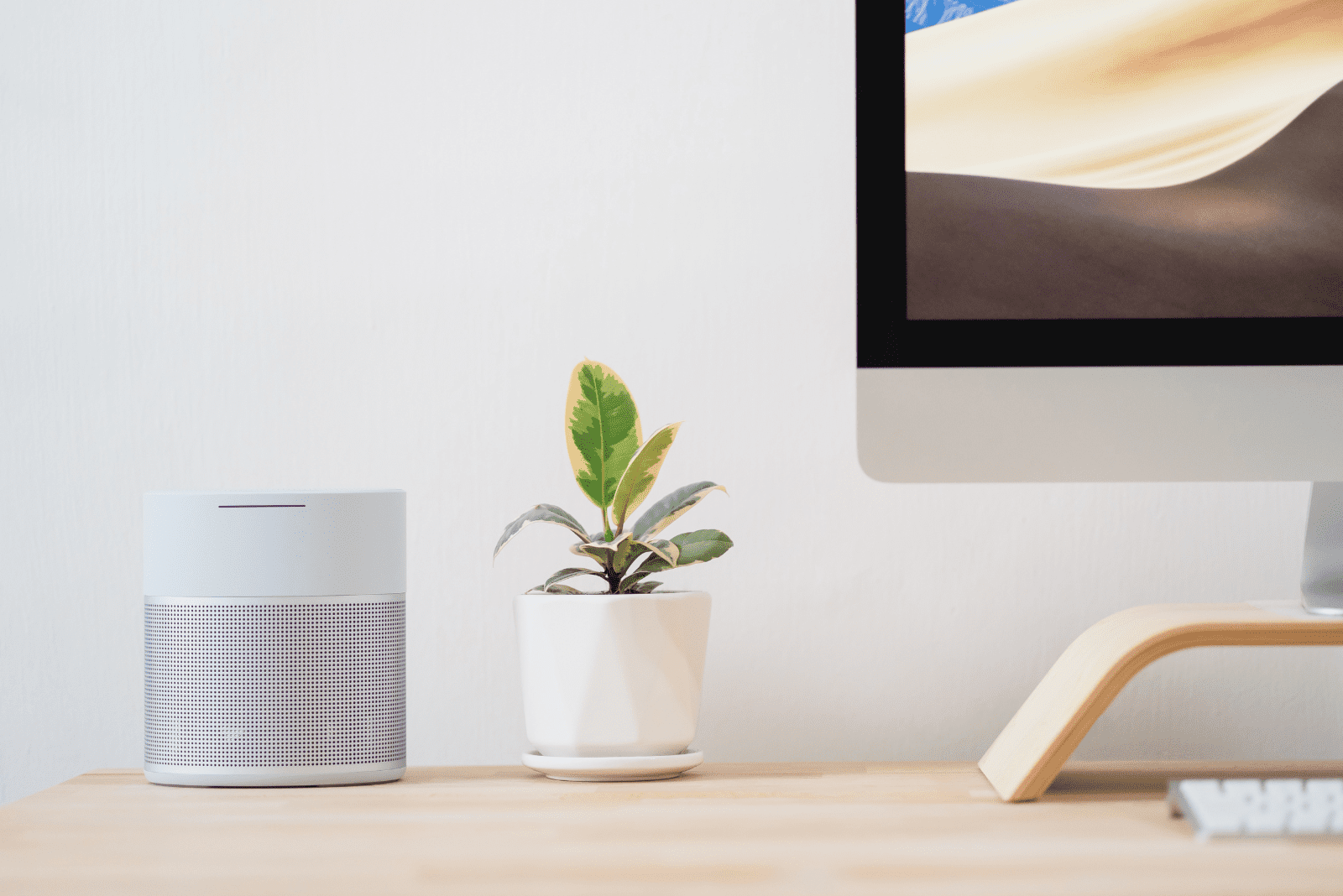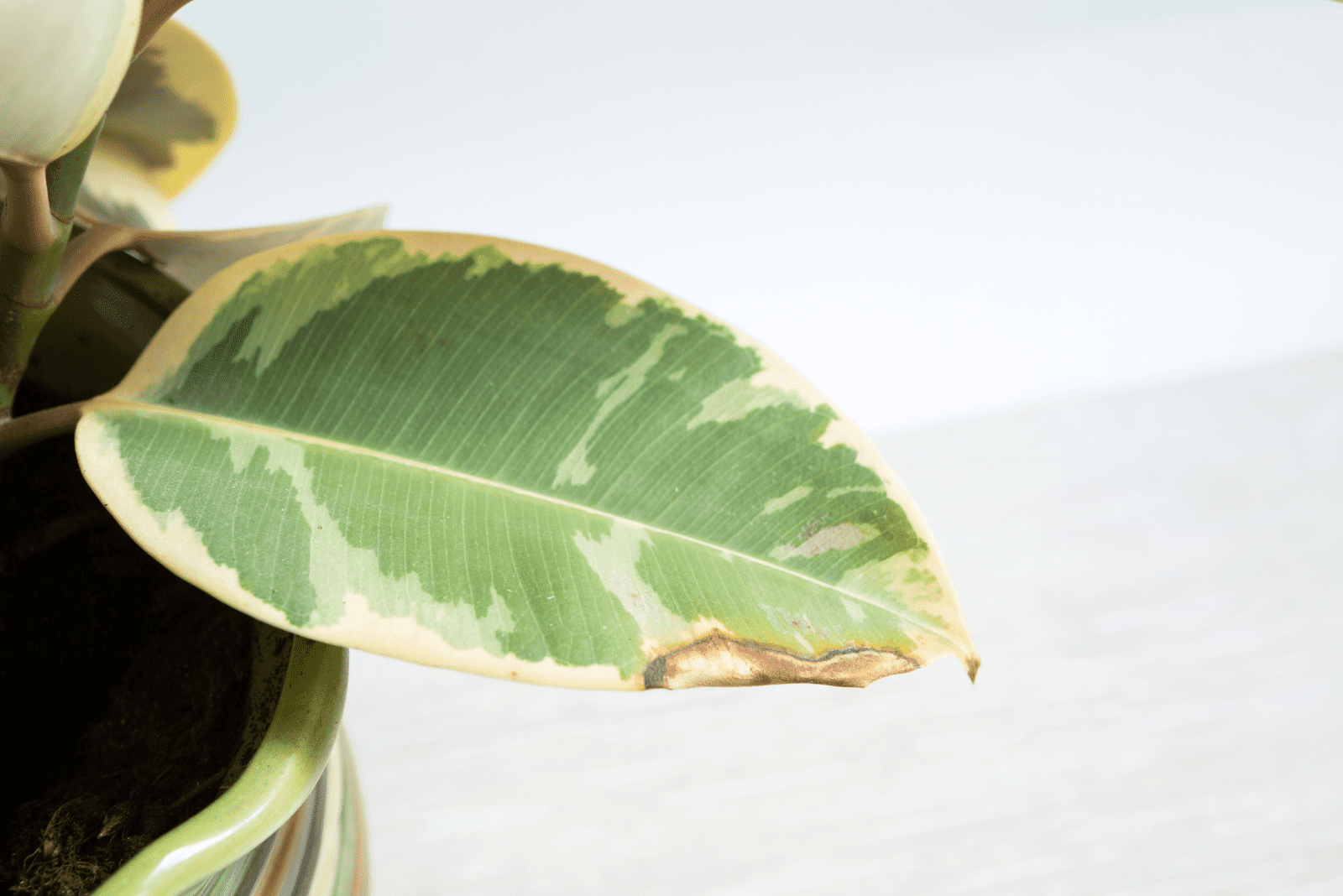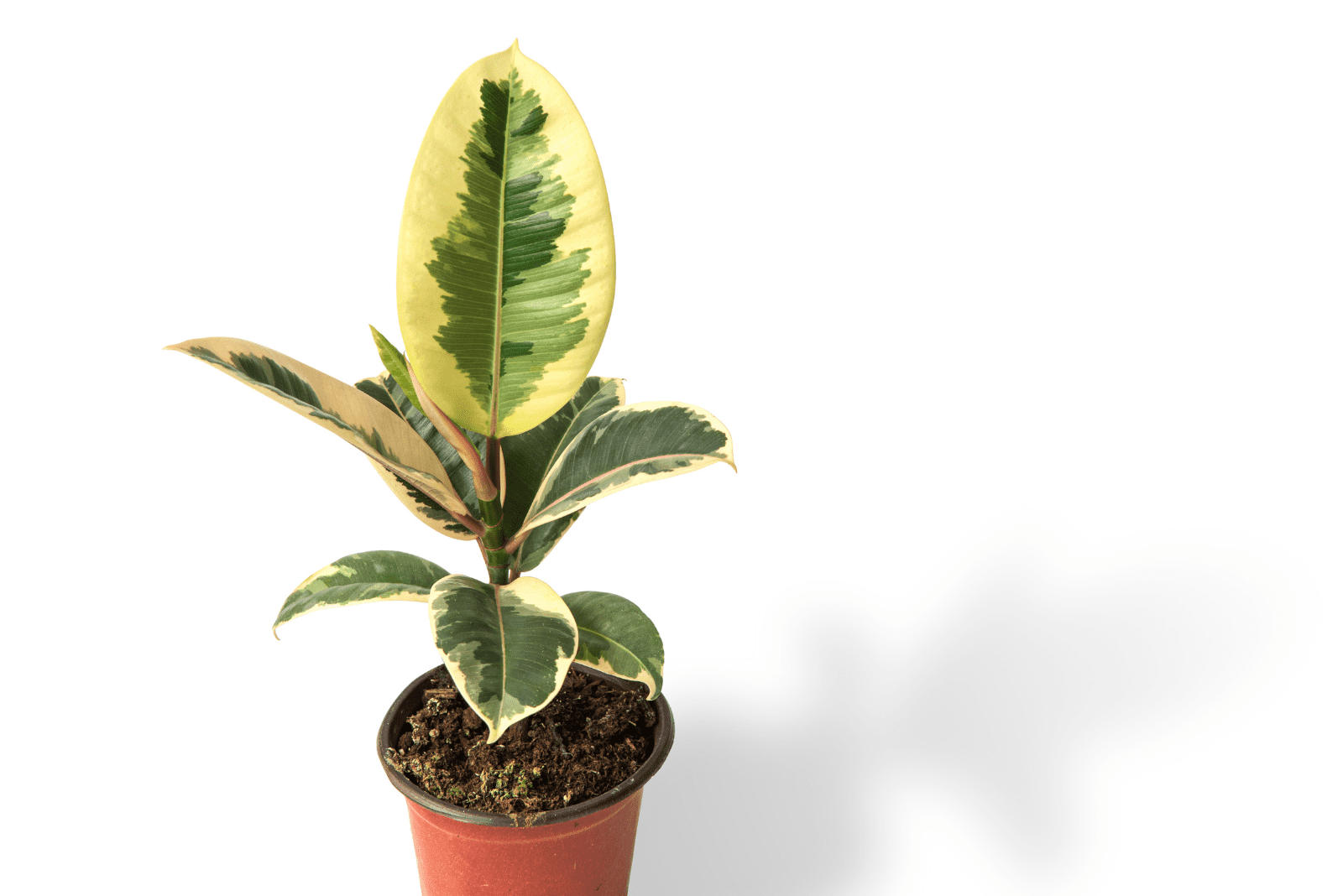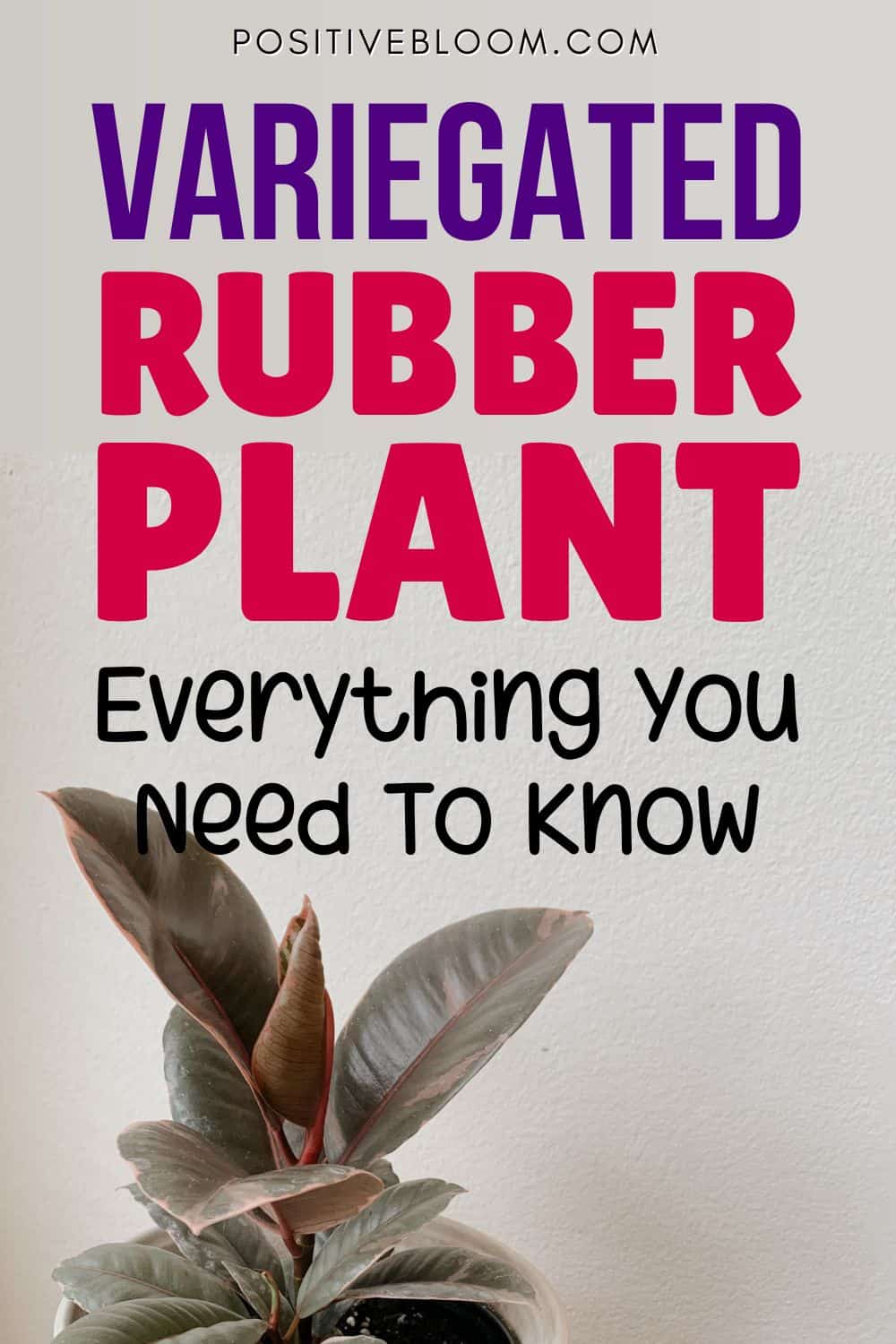The variegated rubber plant is an attractive houseplant that can fit into every decor. Different cultivars have different colored foliage, so there’s something for everyone.
This article includes information on the main features of variegated rubber trees, their requirements, and some common issues you may encounter.
Before we get to all that, let’s look into the general characteristics of this plant:
[table id=304 /]
Variegated Rubber Plant: Features
Variegated rubber tree plants are quite popular due to their looks, mainly because of their charming and colorful foliage.
In the paragraphs below, you will learn more about their growth habits and stem structure, foliage, and flower characteristics, which all distinguish this variety from other ficus plants.
Stem Structure
The Ficus elastica is an interesting plant, mainly because of its structure. It can be a climbing plant, so you should stake it on a trellis, bamboo stake, or any moss pole alternative you prefer (if you hate the mess moss poles can create).
However, an interesting fact about this ficus plant is that it can be grown as a tree or bonsai. It doesn’t really branch naturally, so you should prune it quite often to get a bushier look and the thicker stems of a real bonsai tree.
The color of the stems varies between brown and green. The lower parts are darker brown, while the upper parts assume a green shade.
Foliage Characteristics
Variegated rubber trees have 5-12 inch long green leaves streaked with beautiful colors. The color of the variegation isn’t necessarily white; there are many cultivars with yellow, cream, red, pink, and green streaks and shades that will make you love this plant even more!
Unfortunately, the burgundy and dark green leaves are lost among all those colors, but there’s plenty to admire either way.
The foliage of this plant is large and broad, although its width is not constant as it narrows a bit towards the outer end.
Flower Features
When we talk about leafy plants such as ficus, philodendron, monstera, etc., flowers are not usually the first thing that comes to our minds.
And for a good reason!
Ficus blossoms are quite insignificant and found in a receptacle that resembles some sort of fruit. You have to open this part of the plant in order to get to the flower.
But you won’t have to worry about this at all because ficus plants very rarely produce blooms indoors.
In its native habitat, you may notice red, pink, or orange capsules throughout spring and summer, but this plant can produce flowers in other seasons if the weather is warm enough.
Variegated Rubber Plant: Care Guide
Variegated rubber plant care is pretty straightforward: it needs indirect light, water, high humidity, and well-draining soil to prosper.
Even though it is undemanding, it still requires some care for its healthy growth and development. Check out our care tips to make growing this plant a walk in the park!
Light Requirements
This plant is native to tropical rainforests, light forests, shrublands, etc., so you should try and mimic those conditions to the best of your ability to help this plant thrive.
One of the main characteristics of its native habitat is that there isn’t much direct sunlight, which is why this plant adapted to low-light conditions.
Variegated rubber plants require bright light for optimal growth, whether you grow them as climbers or bonsai.
You can even grow them in low-light conditions, but it can lose its glamorous variegation, so it’s probably not the best option.
Not receiving enough light can also make it leggy and unhealthy because only the green parts contain the chlorophyll that can photosynthesize, which is vital for proper development.
Plants will elongate their stems to search for light, and the plant, weakened by the lack of food and energy, cannot support them, so they droop.
You can place your ficus near an east-facing window where there’s enough indirect sunlight for it to thrive, but no direct sun rays that can cause burns.
Water And Humidity
Watering rubber plants adequately is one of the key aspects of keeping them healthy. This ficus comes from the tropical parts of Asia, but that doesn’t mean you should flood it with water every day.
Too much irrigation will only lead to overwatering and root rot, causing more problems than it solves.
Therefore, always check the soil before watering. You can use your fingers or a moisture test kit from Amazon to check whether your rubber plant needs to be watered.
A general rule for watering rubber plants is to do it approximately once a week during their growing season and once every other week when the plants enter dormancy.
Plants may need more water if you expose them to more light or if the temperatures are higher, so bear this in mind when irrigating your ficus.
Furthermore, there is such a thing as the best water for your plants. For instance, hard water contains plenty of calcium and magnesium, and even though it is suitable for your plant initially, it can lead to build-up that may prove harmful.
Tap water may contain too much chlorine, so you should always let it sit for about 24 hours before using it.
Finally, the critical thing is to find the right balance between too much and too little water and to use a type that won’t over-mineralize your ficus elastica.
Humidity
The variegated rubber tree is an indoor plant that loves humidity. Average household humidity is between 30-40%, although it might be slightly higher in the summertime.
However, it is still not enough for your Ficus elastica, which needs at least 50% to thrive.
We have put together a few ways of increasing humidity in your home in the paragraphs below.
Humidifier
Using quality humidifiers is one of the best ways of quickly increasing the air moisture around your plants. Simply turn it on and let it do all the hard work.
However, you might not like the way it fits (or rather doesn’t fit) into your home decor, or it might be too much money for a gadget you’ll only use for one plant.
Luckily, we’ve got a few cost-effective tips in store for you!
Grouping Plants
Placing your plants with similar needs all together is an excellent way of increasing humidity.
It reduces the air circulation around your green friends, and their leaves need more time to dry out. Moisture that exits the plant via transpiration sticks around your plants and keeps them hydrated.
However, some plants need more moisture, but you can combine different methods and see what works best for your ficus.
Moving Your Plants To Humid Rooms
Some rooms are more humid than others, such as bathrooms and kitchens, so you can move your plants to those locations if you don’t want to take on an extra chore like misting.
You should also move your plants away from drafty windows, doors, heaters, and ACs because they all make the air drier and create an environment not suited for your rubber plant.
Pebble Tray
Do pebble trays work for humidity? It’s an age-old question, and there are conflicting opinions on the method.
Water that evaporates from the tray usually disperses before it reaches the foliage of tall plants, so it wouldn’t be of much use to your ficus.
However, if you decide to grow this plant as a bonsai, you could place it on a gravel tray and moisturize it that way, as vapor would be able to reach the roots and leaves.
Misting
We saved the easiest for last: spraying your plants with water. It doesn’t get any easier (or more budget-friendly) than this.
Simply mist your plant’s foliage every couple of days, and that’s it. Of course, always allow it to dry out between misting, and don’t add too much moisture as it can lead to dangerous fungal diseases.
Temperature
This plant is not tolerant to sudden temperature swings, so you should avoid placing it near drafty windows, heaters, ACs, etc.
Also, try to maintain more or less constant temperatures between 75-80°F during the day and 60-65°F during the night.
Ficus plants are quite sensitive, and temperatures below 55°F may lead to drooping, stunted growth, or even death! You should avoid exposing it to cold weather as it decreases enzyme activity and disrupts nutrient absorption.
Soil And Fertilizer
The Ficus elastica loves a potting mix that drains well but retains moisture at the same time. Thankfully, you only have to mix peat moss and coco coir with perlite or smart gravel to achieve this.
Moss and coir can hold water for a few days and release it whenever your plant needs it, so you won’t have to irrigate it too frequently.
On the other hand, perlite and gravel make the soil looser and more aerated, so the roots of your plant won’t suffocate due to a lack of oxygen. They also make the substrate more draining, which means you won’t have to worry about water clogging.
But these materials are always optional. For instance, you can mix one part potting soil or peat moss, one part perlite or horticultural sand, and one part bark.
You just have to use water-retentive and draining materials in the correct ratio.
But don’t worry, plants aren’t that sensitive and won’t die if you plant them in slightly heavier or looser soil. Just adjust the watering, and they’ll be fine.
Fertilizer
If you want to see new growth quickly, you should fertilize your rubber plant from time to time.
But don’t overdo it because overfertilization is not something to be taken lightly.
Thankfully, there are great liquid fertilizers for indoor ficus plants that you can use safely. Simply follow the instructions for diluting them.
Of course, there are special times when you can feed your plants. You should fertilize your ficus once or twice a month during its growing season because that’s when it’s most active and will benefit from extra nutrients.
You should reduce fertilization in winter (or completely discontinue it) as your plant doesn’t require additional minerals.
Repotting
Repotting plants is important because it gives them more room to grow and introduces fresh nutrients they can use.
Younger plants should be repotted more often (every 1-2 years) because they grow faster. However, established and older plants can go up to 3 years without needing to move.
But the Ficus elastica is basically a tree, and it needs room for its roots. Therefore, always choose a pot 1-2 sizes larger than the previous one.
Also, choose a container with drainage holes so that the excess water can freely escape through them and not clog your plant.
Another thing that you should keep in mind is the time of repotting. It is usually done at the beginning of the growing season because your plant will have plenty of time to adjust to the new soil and prepare for dormancy.
Here are some tips for repotting rubber plants:
Propagation
Propagation is an excellent way to get new plants to gift to your friends and family or decorate more rooms in your home.
The good news is that the variegated rubber plant can be easily multiplied through stem cuttings, so we’ll examine this process step-by-step.
Step 1. Sterilize the equipment and clean the area to minimize the transfer of bacteria and fungi to your plants. Put on some protective gloves because ficus plants contain a lot of sap that can cause skin irritations.
Step 2. Choose a healthy stem with spotless leaves and as many leaf nodes as possible. A proper cutting should be approximately 6 inches long with at least four leaf nodes.
Step 3. Remove all bottom foliage, leaving only one leaf at the top, as this will divert the plant’s energy into forming new leaves and roots instead of wasting it on the existing foliage.
You can also roll the leaf and fasten it with a rubber band to prevent further loss of moisture.
Step 4. Dip the cutting in the rooting hormone and plant it in a soilless mixture loosened with perlite. Support the cut stem with a tiny wooden stake, spray the growing medium with water, and place the pot in a zip-lock bag to prevent moisture loss and increase humidity.
Step 5. Place the cutting in a warm area with plenty of indirect sunlight and mist the substrate with water every now and then. Make sure that the growing medium doesn’t dry out completely.
After a month or so, the roots will start to form, and you can check it by slightly tugging the cutting. If it doesn’t come out easily, the root system has started to develop, and you’ll have a new plant in no time!
Pruning And Cleaning
Trimming your plants is important to preserve their health. You should remove old, discolored, and diseased leaves because they only waste your plant’s energy and can even spread diseases if they are infected.
You don’t have to prune your variegated rubber plant too often, but you can do it if you want it to branch and have a bushier look.
Cleaning is another important aspect of plant maintenance. You can clean the broad leaves with a damp cloth and some dish soap or a wet towel.
Another interesting method is cleaning leaves with olive oil, which can make them glossier and keep pests such as aphids away. However, it can also make your plant look greasy, and when the dust lands on leaves cleaned with olive oil, it looks dirtier than it actually is.
Choose the method that suits your plant and pat the leaves dry (if the humidity around your plant is high) to avoid possible fungal infections.
Common Problems
Growing plants has its ups and downs, and there are quite a few downs!
Pests, diseases, discolored leaves, and droopy plants are the most common ones, but you’ll be glad to hear that all these issues can be avoided with just a little bit of care.
Pests
Some of the most common pests that attack rubber plants are aphids, spider mites, and mealybugs.
The good news is that they infest plants that aren’t at their best, so make sure you take good care of them to save yourself a lot of trouble.
If they do get attacked by these annoying bugs, however, the key thing is catching the infestation early. You will be able to get rid of them more easily, and your plant won’t suffer that much.
Monitor your plant consistently, and if you catch sight of even a single insect, remove it by hand or with a Q-tip dipped in rubbing alcohol.
You can also place the plant under a stream of running water to remove larger groups of bugs or use horticultural oils and insecticides if nothing seems to be working.
Diseases
The most common diseases are leaf spots caused by different bacteria and root rot.
Leaf spots usually develop in hot and humid conditions, and you can avoid them by improving air circulation, reducing indoor temperature, and not wetting the leaves.
You can recognize them by water-soaked lesions that turn yellow or even brown as the disease develops.
You should isolate the diseased plant as soon as you notice the first symptoms, remove the infected parts, and treat the entire plant with bactericides (or fungicides if fungi caused the disease) as a preventive method.
Root rot is caused by overwatering and fungi that multiply in wet conditions. You can recognize it by the plant’s stunted growth, yellow leaves, and droopiness.
However, the only way you’ll know for sure whether your plant is infected with this disease is by inspecting its roots.
Take the plant out of its pot, and if the roots are mushy, soggy, or dark (brown or black), you should remove them and treat the rest of the roots with fungicide if need be.
Repot the plant in new soil and a new pot (or clean the old pot thoroughly), and adjust the amount and frequency of watering.
Yellow Leaves
Some common causes of yellow leaves on your Ficus elastica are either over or underwatering. Always adjust the watering schedule to your plant’s needs so that you don’t stress it.
Of course, watering is not the only cause of discolored leaves. A yellowish hue may appear due to improper lighting (too much or too little) and high or low temperatures.
Pot-bound plants may also take on a yellow shade because they cannot absorb enough nutrients for proper development, so you should repot them in a larger pot every once in a while just to be on the safe side.
Thankfully, you can avoid this unsightly problem by simply tending to your plant.
Brown Foliage And Edges
Brown foliage is usually a sign that your plant is getting too much light and is probably sunburnt. The leaves also become crispy and very fragile, and the best way to deal with this issue is to remove the affected leaves and take your plant to a spot with indirect light.
Improper lighting is not the only cause of brown foliage. Overwatering can make older leaves turn yellow or brown, so you should check the soil and reduce watering if it’s dripping wet.
Underwatering, water impurities (such as those found in tap water), sudden temperature swings, over-fertilization, and low humidity can also cause brown leaves.
The best cure for this issue is taking care of your plant and ensuring it has everything it needs.
Drooping Plants
Drooping plants can be caused by overwatering, underwatering, too much or too little sunlight, and nutrient deficiency, so you should do your best to meet all its requirements.
Drooping foliage is not a problem in itself, but it can be a symptom of more severe issues, such as root rot.
Monitoring your plant can get you ahead of this problem, and you won’t have to lose valuable time dealing with something that could have been avoided.
More About Variegated Rubber Plants
Variegated rubber trees are fascinating plants, and there’s loads more to discover about them.
This section brings you some more facts about their origin, cultivars that might interest you, and a word or two about their toxicity.
Origin And Background
The variegated rubber plant belongs to the family Moraceae and is found throughout southeastern Asia in China, Malaysia, India, Indonesia, Nepal, and Myanmar.
It contains latex, which has been used to make rubber, but this plant is not the primary source of rubber. The Pará rubber tree is the main source of rubber as we know it.
Cultivars
Some of the most popular rubber plant cultivars are Ficus elastica ‘Tineke,’ ‘Ruby,’ and ‘Burgundy.’
The Tineke variety has dark and light green foliage streaked with light pink variegations, while the color of the Ruby cultivar is much deeper and darker.
Ficus elastica ‘Burgundy’ is not a variegated variety, but is still among the most favored rubber plants due to its deep shade. This plant looks almost black, so it’s no wonder it has found its way onto the list of mesmerizing black houseplants.
Toxicity
Rubber plants contain latex in their milky sap, which makes them poisonous to humans and pets. But latex wouldn’t be toxic if it weren’t for caoutchouc, which makes latex elastic and causes irritations on the skin, around the eyes, and mouth.
However, a plant doesn’t have to kill you or your pets to be considered toxic. This ficus can cause mild or severe dermatitis, decreased appetite, drooling, vomiting, and diarrhea for your pets, so if you’ve ever asked yourself: “Is bonsai toxic to cats?”, you should know that this one is.
You Asked Us
Believe it or not, there are still some unanswered questions about rubber plants and their variegations!
We’ll talk more about these subjects in the section below, so stick around!
Are variegated rubber plants rare?
No, variegated rubber plants aren’t that rare, and you can get some of the most attractive cultivars, such as Tineke and Ruby, on Amazon for less than $25.
How do you increase the variegation of a rubber plant?
Unfortunately, there isn’t a magic cure that can make your plant more variegated, but you can keep it in bright light in order to keep the existing color and make it more bright.
However, avoid direct sunlight as it can burn your plant’s leaves and turn them brown (which is probably not the color you’re going for).
You shouldn’t keep variegated plants in low-light conditions because their color will fade, though their health won’t diminish.
Is the variegation of a rubber plant a mutation?
Yes, the variegation of rubber plants is a mutation, but it appears naturally, meaning you can propagate this plant without worrying about losing its beautiful color.
The mother plant will pass on its genetic material to the daughter plant, and you will have a colorful indoor jungle in no time.
What is the variegation effect on a rubber plant?
Some experts believe that variegated leaves are an evolutionary defense mechanism against pest infestations. The insects might think that the plant is infected with some disease and dying and stay away from it.
Variegation is actually a part of the plant lacking chlorophyll and can be inherited or caused by viral or chimeric (random) mutations.
Final Word
This article included everything you need to know about the variegated rubber plant, including its main features, a care guide, as well as solutions to the most common issues that may befall it.
This variety has many attractive cultivars, all of which have similar needs, so you only need to pick one to adorn your reading room.
Enjoy this beauty, and until next time!
Like this post? Share or pin it for later!

